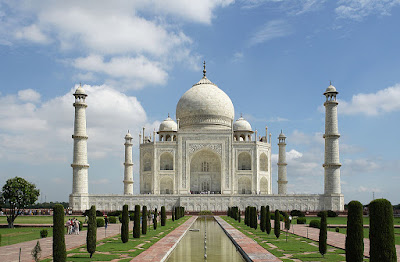TAJMAHAL
TAJMAHAL
Standing majestically on the banks of River Yamuna, the Taj Mahal is synonymous to love and romance. The name "Taj Mahal" was derived from the name of Shah Jahan's wife, Mumtaz Mahal, and means "Crown Palace". The purity of the white marble, the exquisite ornamentation, precious gemstones used and its picturesque location, all make a visit to the Taj Mahal gain a place amongst the most sought-after tours in the world. However, until you know the love story behind the construction of the Taj Mahal, the beauty of the same would not enliven in your heart and mind and instead would come up as just another beautiful building/monument. It is the love behind this outstanding monument that has given a life to this monument. Come and explore the visceral charisma that it emanates
At the brink of dawn when the first rays of the sun hits the dome of this epic monument, it radiates like a heavenly abode, cloaked in bright golden. And then at dusk, basking in the glory of moon, it shines like a perfectly carved diamond; appearing as if straight owwut of some magical tale, leaving the viewers awestruck by its sense of grandeur. Nothing short of an architectural marvel, no wonder it stands proud at being one of the Seven Wonders of the World. And the rich beauty of this visual spectacle turns visceral when one hears the story behind it. The story of Taj Mahal!
Taj Mahal, "the epitome of love", is "a monument of immeasurable beauty". The beauty of this magnificent monument is such that it is beyond the scope of words. The thoughts that come into the mind while watching the Taj Mahal of Agra is not just its phenomenal beauty, but the immense love which was the reason behind its construction. Mughal Emperor Shah Jahan got this monument constructed in the memory of his beloved wife Mumtaz Mahal, with whom he fell in love at the first sight. Ironically, the very first sight of the Taj Mahal, the epitome of love and romance, also leaves visitors mesmerized and perpetually enthralled. It was commissioned in 1632 by the Mughal emperor, Shah Jahan (reigned 1628–1658), to house the tomb of his favorite wife, Mumtaz Mahal. The tomb is the centrepiece of a 42-acre complex, which includes a mosque and a guest house, and is set in formal gardens bounded on three sides by a crenellated wall.
Construction of the mausoleum was essentially completed in 1643 but work continued on other phases of the project for another 10 years. The Taj Mahal complex is believed to have been completed in its entirety in 1653 at a cost estimated at the time to be around 32 million rupees, which in 2015 would be approximately 52.8 billion rupees (US$827 million). The construction project employed some 20,000 artisans under the guidance of a board of architects led by the court architect to the emperor, Ustad Ahmad Lahauri.
The Taj Mahal was designated as a UNESCO World Heritage Site in 1983 for being “the jewel of Muslim art in India and one of the universally admired masterpieces of the world’s heritage”. Described by Nobel laureate Rabindranath Tagore as “the tear-drop on the cheek of time”, it is regarded by many as the best example of Mughal architecture and a symbol of India’s rich history. The Taj Mahal attracts 7–8 million visitors a year



Comments
Post a Comment